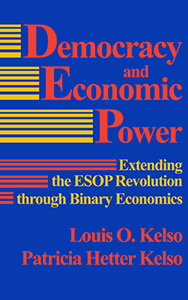-
by Louis O. Kelso and Patricia Hetter*
Because they are unemployed?No. There are a significant number of people who are wealthy, though unemployed. Indeed,there are people who are rich who have never been employed — even third and fourthgeneration unemployed.Because they are uneducated or undereducated?No. There are significant numbers of people who are successful and rich, though littleeducated, miseducated, and even uneducated. Indeed, the relationship between liberaleducation and wealth is generally grossly misrepresented. Historically, and logically,education follows the acquisition of wealth, rather than preceding it.Because they lack vocational training?No. There are people with no vocational skills who are rich.Because they are lazy?No. There are lazy people who are rich. And, of course, there are people who look lazybecause the viewer may have a narrow concept of creativeness, but who are neverthelessrich.Because they are unhealthy, undernourished?No. There are unhealthy people who are rich, and even people who by choice areundernourished, but who nevertheless are rich.Because of the color of their skin?No. There are rich people of every race and color.Because they live in a ghetto or slum area?No. There are no wealth or income restrictions imposed on ghetto or slum areas. Generally,rich people prefer affluent surroundings. But poor people would be no less poor if they livedelsewhere; they might in fact be poorer still, or at least feel so. The straightforward answeris that poor people are poor because they possess neither accumulated wealth nor theeconomic power to produce affluence.Why so many hard-working Americans stay poor:Economic productive power is of two sorts:1. The labor power inherent in a reasonably sound mind and body. This is given each personby nature. It is a power that can, within limits, be increased by training, discipline,apprenticeship, education and experience, but except for a numerically small fraction of thepopulation — mostly professional people and highly creative artists — labor powerproduces subsistence, not affluence production. Except for a few professionals and artists, and slave owners in slave societies, itis capital — the other factor — the world around that produces affluence.MOST AMERICANS ARE ECONOMICALLY HANDICAPPED BECAUSE THEY OWN NOPRODUCTIVE CAPITAL — and capital produces most of the wealth.What is even more to the point: Our national economic policy is not aimed at enabling poorpeople to become capital owners and thus to both enable the economy to produce a generallyaffluent level of goods and services, and to enable individuals to produce their own affluentincomes.— Our national policy is to fight poverty through full employment only. (See theEmployment Act of 1946.)— Our banking and financing techniques are devoid of significant methods to enable thosewithout capital to buy it and pay for it.— Each year in the U.S., business and financial management makes decisions which bringinto existence about $100 billion in newly formed capital investments.Although this capital would not be brought into existence unless it will quickly (three to fiveyears, generally) pay for itself, it is financed so that it becomes owned by the top 5% of familieswho already own (and have always owned) all existing capital.— Their consumer needs and wants are saturated. They will not consume more. In spite ofthis vast annual increment to their economic power to produce, their only choice inspending their increased incomes is to invest in still more productive capital.This new capital could be financed so that it could be bought by poor Americans, who could payfor it out of the wealth it produces, for newly formed capital in well managed businesses isinherently financeable. Thus, new productive power of the economy could be brought intoexistence in a way that would raise the productive power of the poor by enabling them toproduce income through capital ownership, and so raise their power to consume.MOST AMERICANS ARE POOR BECAUSE THE U.S. SUBSCRIBES TO PRE-INDUSTRIAL ONE-FACTOR (LABOR) ECONOMIC CONCEPTS THAT CONDEMN US TODISTRIBUTE THROUGH LABOR — OFTTEN MAKE-BELIEVE — THE WEALTHPRODUCED BY CAPITAL.In other words, we use the wealth produced by capital to subsidize economically unnecessarytoil.AMERICA NEEDS TO UPDATE ITS THINKING ABOUT ECONOMICS NOW, BEGINNINGWITH ECONOMISTS.* © 1976, Louis O. Kelso and Patricia Hetter2. Physical capital — the land structures and machines that make up the second factor of

